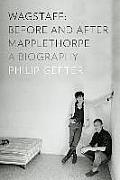ArtmeetsLove :: WAGSTAFF: BEFORE AND AFTER MAPPLETHORPE
 ��Philip Gefter’s WAGSTAFF: BEFORE AND AFTER MAPPLETHORPE
��Philip Gefter’s WAGSTAFF: BEFORE AND AFTER MAPPLETHORPE
In all honesty, I had little knowledge of Sam Wagstaff coming into this book. My eye stuck on the ���Mapplethorpe��� in the title, the cover���s photo of the young man so loved in Patti Smith���s Just Kids, her hippie soul twin, and immediately wanted to see another side of Robert Mapplethorpe���s life, another person on whom Robert acted as less of a foil than another half of a heart. Anyway, even if Mapplethorpe was the draw, I���m so glad I picked up this book / finally opened my eyes to the major cultural and art-world shifter that was Sam Wagstaff.
Brought up in wealth, luxury and almost ushered straight into the inner circle of suits, maybe nothing���s more impressive about the direction Sam took in life than the fact that, so easily, he could have taken a direction centered on money, summer homes and the typical white male checklist. But instead, bored by the corporate life of advertising he tried out in his younger years��� and really, this is the ���Mad Men��� life in the few years before the ���Mad Men��� time ��� Sam studied extensively in art history, preferring the scenes on the street to those lived in the big business skyscrapers.
It���s easy to imagine the man fitting in with the counter- cultures circles at the time, despite (or maybe because of) his handsome looks. Andy Warhol took to the man, we���d hope in mutual admiration, mutual friendship created over an intense love of art, but more likely, because Sam was a handsome chiseled face Andy wanted to surround himself with.
His days in the 60s sound so idyllic, at least in my mind. Floating through art fairs, buying up small paintings, prints, and almost unusually, photographs, Sam stocked the stuff, still covered in paper around his mainly bare apartment. He wandered deeper into circles other art historians would shake their heads at, making himself a part of art history to come rather than an admirer of the past.
Enter Robert Mapplethorpe, the bold young artist, a photographer whose portraits (especially those of his college-girlfriend, then-roommate Patti Smith) are still haunting today. It���s weird to think about today, when ���Photos of the Year��� win Pulitzers, but in their days, photography was thought of less as an art form, more of a utilitarian tool to capture an image. Despite the boy being a compulsive photographer, collage-maker, and having little to no involvement in the ���true��� arts of the time like painting, or drawing, Wagstaff took Mapplethorpe under his wing, serving as Robert���s patron, and soon, his lover.
Patti Smith, Mapplethorpe���s first love, is quoted in the book giving advice to the many men that tried to make Robert fall in love with him ��� to win Robert���s heart, you must love his work. Wagstaff, Patti and the author believe, was the only one to truly understand this.
It doesn���t last (spoiler alert), their lives as patron and artist continue, the tension of their relationship there throughout much of both of their respective careers. Yet, their love for one another helped shape the art world immensely. Wagstaff, with the money and the wealth and the power to collect and curate based on his own taste, was undoubtably shaped and influenced by the power of Mapplethorpe���s photographs and his passion for the medium. And of course, Mapplethorpe, without the help and financial support of Wagstaff would most likely have remained a side note to the story of Patti Smith.
Wagstaff, it should forever be known, was one of the most influential collectors and art appreciators that pulled photography up into the top rings of art society, and anyone who thinks otherwise, anyone interested in how he did it, or anyone interested in art and love, must read this book.




